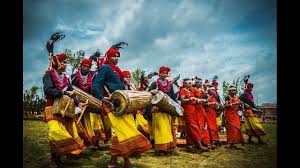
Karma song
Many folk dances are prevalent in the thriving folk culture of Chhattisgarh. One of these popular folk dances is 'Karama' folk dance. Karma dance is performed by the tribes residing in the districts of Chhattisgarh like Bilasupar, Raipur, Durg, Rajnandgaon, Raigarh, Surguja, Jashpur and Korea, Kawardha.
Tribes believe their gods and goddesses live on trees and plants. Since ancient times, there has been a tradition of worshiping ancestors along with trees and plants and animals. They express their gratitude by worshiping deities and trees and plants. Among the worshiped trees, the Sarai and Karam trees are prominent. Tribal groups gather under the tree once a year to worship and celebrate. They have special significance in Karma dance.
Folk festivals are directly related to agriculture and environment. The folk life of the tribes of Anchal is basically based on agriculture and forest. The farming community expresses its sentiments through folk festivals. The local festivals here are Karama, Chherata, Ganga Dussehra, Kathori, Hareli, Teeja, Nawakhai etc. Of these, the 'Karama' festival is one of the most popular folk festivals celebrated by the tribes of central India. The dance performed on this festival is called Karma dance.
A second aspect of this festival has been brought to the fore by connecting karma and luck with the original spirit. Karama is the epitome of dance-song karma that gives us the message of karma.
Karma ritual
The word 'Karama' denotes Karma (diligence) and Karam (fate). 'Man should do good deeds regularly and luck should also support him', with this desire the deity Karam is worshiped. This festival is celebrated on the Ekadashi of Bhadrapad Shukla Paksha. In Sarguja zone, on this day, the sisters fast for the longevity of their brothers throughout the day, and break the fast by taking prasad after worshiping Karam Devata at night.
In the Karma festival, a branch of tree called 'Karami' is traditionally buried in the courtyard of the Patel or prominent person of the village. That Dali is considered to be the symbol of deity and is worshiped. Women sow jowdgehundhmakka in the basket on the day of Teeja festival, which has increased till Karma festival, a week before the Karma festival. In the local dialect, it is called 'Jai'. In the same 'Jai', they light a lamp of clay, decorate it with flowers, and place a cucumber in it and offer it at the feet of Karam Devta. After this, with the help of hand, listen to the story of Karam Devta in local language.
After worshiping the deity and offering prasad, the Karma dance is performed by wandering around the deity throughout the night. Women dance in a circle in a series and the middle men are singers, instrumentalists and dancers. Karama dance is also performed in Rahe Karama (Bhadrapada Ekadashi), in the Eight Parva (Sri Krishna Janmashtami), Teeja Parva (Haritalika Teej), Jintaviya Parva (Putrakashwaka), Dashain Parva (Dussehra) and Deothan Parva (Karthik Ekadashi). Mander, cymbals, mohri (shehnai) etc. are used as instruments. In the Karma festival, after serving the deity Karam through song and dance throughout the night, immerse them before sunrise.
There are many stories regarding the origin of Karma, such as the story of King Karmasena, the story of Karma Rani and the mention of Karma Dev in the story of seven brothers, etc., which are related to the origin of Karma dance around Karma Puja. They fall. The story of these is as follows-
The kingdom of a king named Karma Chand was very happy and full of Dharma splendor. Due to which the neighboring kings were very jealous. An envious neighbor is attacked by the king, and then his kingdom collapses.
Concerned with these incidents, the king was seen burning some lamps at some distance in the forest and saw the deity. The king was surprised to see this. He ran and held the feet of the deity and narrated the story of his calamity in front of the deity. The deity gave some directions to get rid of his sufferings. According to the deity, he got the middle of the tent to be dung by virgin girls. The boys dug in the middle of the courtyard and brought a tree. The girls fasted and worshiped Karma Dev at night. The dance took place throughout the night, and the immersion was done in the morning. The king regained his kingdom and started worshiping the Kadam tree with great fanfare every year in the capital of his kingdom.
The festival spread to the state under the name of Karma Puja. This Karma Puja and dance became popular as Karma Dance, which is celebrated every year in the tribal areas in the month of Quar.
Every festival has a folk history behind it. There are many legends related to celebrating Karma festival, which are as follows:
The legends
1. According to the tribes of the province of Jharkhand, there were two brothers named Karama and Dharama. Karma explained the importance of karma and Dharma showed the path of pure conduct and religious life. Karma is considered as a form of both of these brothers and their prayers and dances are done every year to please them.
2. According to the tribes of the districts of Raigad, Korba, Janjgir-Champa, Mahasamund, etc. of Chhattisgarh, King Karamsen danced all night to commemorate the presiding deity in the event of calamity on him, which removed his misfortune. Since then, the festival of Karma and Karma dance in the name of King Karamsen is popular.
3. The tribes of Central and Western region of Chhattisgarh believe
